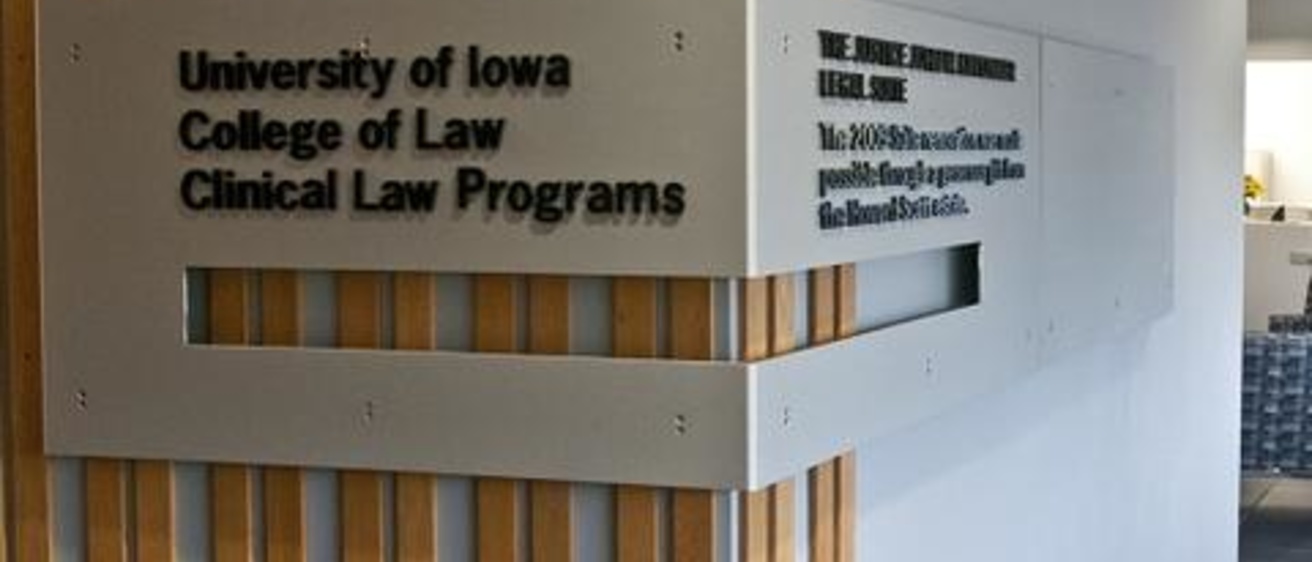University of Iowa Law and Policy in Action Clinic law students and faculty are playing a pivotal role in an initiative to limit the use of physical restraints or seclusion rooms in Iowa schools. They are part of an attorney workgroup that petitioned the Iowa Department of Education to revise its rules and ensure that seclusion rooms and physical restraints are used only emergency situations, are used only as a last resort, and are never used to discipline or punish students.
The group was formed by private attorney Mary M. Richard (Iowa Law, Class of 2004) of Iowa City, and has included representatives from the UI Legal Clinic, Disability Rights Iowa, the Drake Legal Clinic, several private lawyers, and the ACLU. These hand-picked advocates have experience representing and advising students and families on education and special education matters.
Clinical Professor Len Sandler and Clinic Law Students John Huldin and Logan Kraus served as primary drafters of the proposed rules, and coordinated workgroup efforts. Ms. Richard praised their efforts and contributions: “Len and his students did a tremendous amount of research, drafting, coordinating, communicating, etc. Their work was consistently outstanding.” The LPA team reviewed research reports and other literature on seclusion and restraint, as well as best practice materials, judicial decisions, and federal, state and local agency rulings and policies about behavior management, discipline and punishment. They and other workgroup members also compared the laws and regulations of all 50 states. The legal clinic also fielded questions and reworked draft after draft to respond to concerns and comments voiced by the group.
“This workgroup has been an excellent collaboration which at all times has focused on serving the best interests of Iowa’s school children and their families, and promoting the ability of Iowa school systems to succeed in their educational mission,” said Richard. The group’s recent efforts have been reported in the New York Times and other media. (See https://www.nytimes.com/aponline/2017/06/28/us/ap-us-seclusion-rooms.html and http://www.press-citizen.com/story/news/2017/06/27/aclu-calling-iowa-change-rules-seclusion-restraint-schools/433416001/)
The Law and Policy in Action Clinic provides law students the opportunity to partner with grassroots organizations, non-profits, businesses and public officials to solve recurring and systemic problems that cannot be adequately addressed through litigation or traditional legal methods. John Huldin left the workgroup when he finished his clinical semester. Logan Kraus graduated from the College of Law in May. Clinic Law Students Jordan Christensen and Drew Workman did some last minute research for the project at the beginning of the summer clinical semester.
Original group members Mary M. Richard, Nathan Kirstein of Disability Rights Iowa, and private attorneys Edie Bogaczyk, David Roston, and Curt Sytsma signed the petition for rulemaking. Jerry Foxhoven resigned from the group when he learned he was to be appointed as director of the Iowa Department of Human Services. daniel zeno (Iowa Law, Class of 2009), Policy Director at ACLU-Iowa, joined the workgroup in June, reviewed the next-to-the-last draft of the proposed revisions, and continues to participate in and support these critical system reform efforts.
The group’s goals are to ensure that the rules, to the extent possible, would:
- Apply to as many individuals as possible, including an employee, contract personnel, and paid or unpaid individuals who provide services or supports to, and have contact with students. Distinguish between, and have separate provisions regarding restraint and seclusion, and corporal punishment.
- Emphasize that corporal punishment and chemical, mechanical, and prone restraints are prohibited in all circumstances, and that physical restraint and seclusion are methods of last resort to be used exclusively to resolve emergency situations when other techniques would be futile or have failed.
- Define terms and behavior management techniques, such as time-out, physical restraint (and other types of restraints), seclusion, and emergency situation. Creative use or modification of terminology must not define or justify the technique that is employed.
- Clarify what actions constitute corporal punishment, physical restraint, seclusion, time-out, etc. and if, when, how, and by whom they are to be utilized.
- Limit seclusion and physical restraint to emergency situations, when a child’s behavior poses an immediate threat of serious bodily injury to the child or others – and not when behavior might result in damage to property or disruption of a class or education program.
- Detail the minimum requirements for rooms or spaces that are used for seclusion, including dimensions, lighting, ventilation, types of locks, building materials, etc.
- Detail the precipitating events, emergency situations, maximum time limits, monitoring, recording, debriefing an parental notification requirements that apply to any use of physical restraint or seclusion.
- Require that all incidents of physical restraint and seclusion be recorded in a child’s education records.
- Require that a child be evaluated when the school employs behavior management techniques so frequently that they interfere with a child’s access to education.
- Emphasize that all actions and policies be based on research/evidence-based, data-driven, and trauma-informed practices.
For more information, contact
Len Sandler
leonard-sandler@uiowa.edu
Clinical Professor of Law
Director, Law and Policy In Action Clinic
University of Iowa College of Law
Clinical Law Programs
380F Boyd Law Building
Iowa City, Iowa 52242-1113
319-335-9030 (phone)
319-353-5445 (fax)
